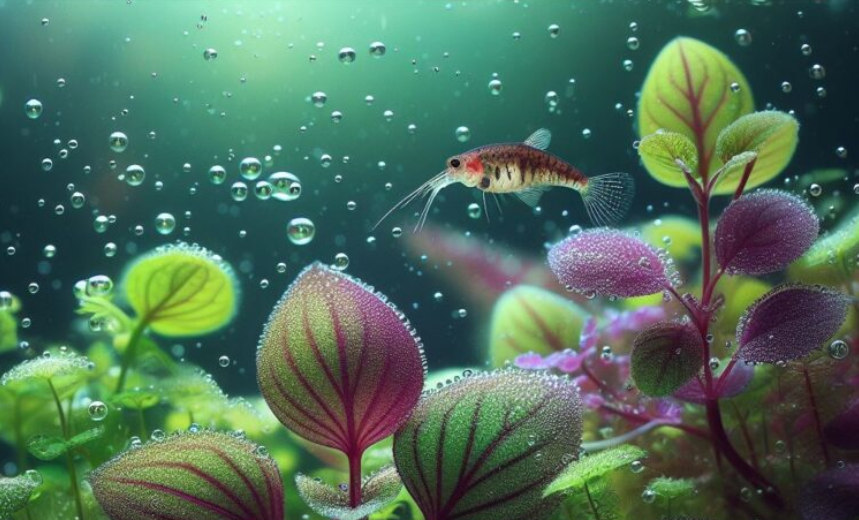If you’re looking for a beautiful and easy-to-care-for aquatic plant, the Bacopa Aquarium Plant is an excellent choice. This plant is known for its lush green foliage and its adaptability to different water conditions.
In this section, we will provide you with the best care and growth tips for your Bacopa Aquarium Plant. Follow these guidelines to ensure that your plant thrives and enhances the beauty of your underwater garden.
Key Takeaways:
- Regular pruning and propagation are essential for maintaining the shape and density of your Bacopa Aquarium Plant, and expanding your collection.
- Providing optimal water conditions, fertilization, and adequate lighting are crucial for the health and vibrancy of your plant.
- It’s essential to identify and overcome common problems such as algae growth, nutrient deficiencies, and pest infestations to ensure the long-term health of your plant.
- Choosing compatible tank mates and enhancing the aesthetics of your underwater garden can also contribute to the overall health and beauty of your Bacopa Aquarium Plant.
- Preventive measures and best practices can help keep your Bacopa Aquarium Plant healthy, including maintaining water quality, proper hygiene, and quarantine procedures.
Optimal Conditions for Bacopa Aquarium Plant
Providing optimal conditions for your bacopa aquarium plant is crucial for maintaining its overall health and promoting growth. The following are the ideal conditions that are suitable for your plant:
| Water Parameters | Lighting Requirements | Temperature Range |
|---|---|---|
| PH: 6.5-7.5 Hardness: 3-8 dKH Temperature: 68-82°F Nitrate: Phosphate: | Moderate to high intensity Full spectrum LED or fluorescent tubes 8-10 hours per day | Optimal: 72-78°F Tolerable: 68-82°F |
Bacopa requires moderate lighting for photosynthesis and carbon dioxide uptake. Keeping the light on for 8-10 hours per day is sufficient for healthy growth. Although it can tolerate a wide range of temperatures, the optimal range lies between 72-78°F. In addition, maintaining a clean water environment with low levels of nitrate and phosphate is crucial.
Remember that optimal conditions may vary depending on the other aquatic life present in the tank, so be sure to research and analyze the best conditions for your specific aquarium setup.
Planting Bacopa Aquarium Plant
Properly planting your bacopa aquarium plant is crucial for its growth and overall health. Here are the steps to planting your bacopa aquarium plant:
- Choose the right substrate: Bacopa plants do well in nutrient-rich substrates and aquarium soil.
- Space the plants: Plant bacopa aquarium plants a few inches apart and at a depth of about 1-2 inches.
- Add water: Fill your aquarium with water until there is about 1 inch above the substrate.
- Prune the leaves and stems: Remove the leaves and stems from the bottom two inches of the plant to encourage new growth and anchor the bacopa plant in the substrate.
- Provide ample light: Bacopa plants require moderate to high lighting conditions. Be sure to place your aquarium in an area that receives ample sunlight or supplement with artificial light.
- Monitor the water temperature: Keep the aquarium water temperature between 72 and 78 degrees Fahrenheit.
- Take precautions: Avoid uprooting or disturbing the plants while planting, as this can weaken the root system and hinder growth.
By following these steps, you can ensure the proper planting of your bacopa aquarium plant and allow it to flourish in its underwater habitat.
Watering and Fertilizing Bacopa Aquarium Plant
Maintaining proper water conditions and providing necessary nutrients is paramount to ensure the health and vibrancy of your bacopa aquarium plant. Watering and fertilization are the two crucial aspects that require your attention to provide the plant with the nourishment and care it needs to grow.
Watering Bacopa Aquarium Plant
Bacopa is an aquatic plant that requires ample water to thrive. It’s essential to keep the water level within the tank consistent to avoid fluctuations that may harm the roots. Underwater plants absorb nutrients and water through their leaves, so the water must be maintained clean and free of impurities.
However, it’s also essential to avoid overwatering, as stagnant water may cause root rot that could harm or kill the plant. We recommend watering your bacopa once every two weeks or as needed by checking the soil moisture or judging from the plant’s growth.
Fertilizing Bacopa Aquarium Plant
Bacopa is a fast-growing aquatic plant that demands substantial nutrients like nitrogen, potassium, and phosphorus to sustain its growth. It’s necessary to provide your bacopa with extra nutrients beyond those provided by the fish and invertebrates in your aquarium to ensure optimal growth.
You can use specific fertilizers designed for the aquarium plants, such as liquid or tablet fertilizers. Follow the manufacturer’s dosage instructions to avoid overfertilization that could lead to harmful algae growth. Alternatively, you can use organic methods like adding decomposing plant matter that will provide more natural nutrients.
| Nutrient | Amount | Frequency |
|---|---|---|
| Nitrogen | 5-10 ppm | Weekly or bi-weekly |
| Phosphorus | 1-2 ppm | Weekly or bi-weekly |
| Potassium | 10-20 ppm | Monthly or as needed |
Be mindful of the water quality and chemical composition when fertilizing, as certain elements may affect the plant’s growth and overall health. Additionally, you can experiment with different fertilization techniques to find the one that works best for your plant and specific aquarium conditions.
Pruning and Propagating Bacopa Aquarium Plant
Pruning and propagation are vital steps to ensure the healthy growth of your bacopa aquarium plant. By removing excess foliage and propagating new plants, you can maintain the shape and density of your plant while expanding your collection. Here are some best practices for pruning and propagating your bacopa aquarium plant:
Pruning Bacopa Aquarium Plant
The best time to prune your bacopa aquarium plant is when it has grown to a certain height, become overly dense or bushy, or developed any unwanted parts. To prune your plant, use a pair of sharp scissors or pruning shears and make a clean and precise cut above the leaf node. This will encourage new growth and prevent any damage or diseases from spreading.
When pruning, consider the shape and height you want your plant to maintain. You can create a more compact and bushy look by trimming the tips of the stem, or allow for branching by cutting just above the node where two leaves meet. Don’t forget to remove any yellowed or damaged leaves as well.
Propagating Bacopa Aquarium Plant
Propagating your bacopa aquarium plant is an excellent way to expand your collection or swap with other aquarium enthusiasts. There are several methods you can use:
- Stem cutting: Cut a stem that is at least 4 inches long, remove the lower leaves, and insert it into the substrate, ensuring that the top of the stem remains above the water level. After a few weeks, new roots should develop, and the stem will start growing new leaves.
- Division: When your bacopa aquarium plant has grown too large, you can divide it by carefully separating the roots and stems into smaller portions. Plant each portion into the substrate, ensuring that it has enough space to grow and its roots are not tangled up.
- Runners: Bacopa may develop runners, which are long stems that run along the substrate and develop new roots and leaves. You can cut these runners and plant them separately to create new plants.
Propagation requires careful handling and patience, but it can be a rewarding process that allows you to diversify and maintain your underwater garden.
Note: Before pruning or propagating your bacopa aquarium plant, ensure that your tools are clean, and you are not spreading any diseases or harmful substances.
Dealing with Common Bacopa Aquarium Plant Issues
Despite your best efforts, bacopa aquarium plants may encounter certain problems. Below are some common issues you may come across and helpful tips on how to address them:
Algae Growth
Algae growth can be an issue for bacopa aquarium plants and can lead to slower growth and nutrient deficiencies. To prevent algae buildup, ensure adequate water movement and regular water changes. Reduce the amount of time your aquarium light is on and avoid placing the tank in direct sunlight.
Nutrient Deficiencies
Like all plants, bacopa requires adequate nutrients to grow and thrive. Nutrient deficiencies can manifest as yellowing leaves or stunted growth. To address this issue, ensure your water has proper nutrient levels and add a liquid fertilizer as needed.
Pest Infestations
Bacopa plants can be prone to pests such as snails, aphids, and spider mites. If you notice signs of infestation, such as holes or spots on leaves, treat the plants with an appropriate pesticide or remove the affected leaves. Regular tank maintenance, including cleaning and water changes, can also help prevent pest issues.
By troubleshooting and addressing common issues promptly, you can ensure the long-term health and beauty of your bacopa aquarium plant.
Compatible Tank Mates for Bacopa Aquarium Plant
When selecting tank mates for your bacopa aquarium plant, it’s important to consider the compatibility of different fish and invertebrates. Ideal companions will not cause harm or disturbance to your plant, maintaining a peaceful and balanced ecosystem.
Here is a list of compatible tank mates for your bacopa aquarium plant:
| Fish | Invertebrates |
|---|---|
| Tetras (Ember, Neon, Cardinal) | Shrimp (Cherry, Amano) |
| Guppies | Crayfish (Dwarf Mexican) |
| Rasboras (Harlequin, Pork Chop) | Snails (Nerite, Mystery) |
| Corydoras (Panda, Julii) |
Remember to research the individual characteristics and requirements of each species before introducing them to your Bacopa aquarium plant tank to avoid any potential conflicts or incompatibilities.
Enhancing the Beauty of Your Bacopa Aquarium Plant
Your bacopa aquarium plant is undoubtedly lovely on its own, but it never hurts to add some complementary plants and aquascaping to take its beauty to the next level. Here are some design ideas and tips to enhance your bacopa aquarium plant:
Complementary Plants
Pair your bacopa aquarium plant with other plants that share similar light and water parameters. Some plant options that complement bacopa include anubias, java fern, and cryptocoryne wendtii. These plants can add interesting textures, colors and contrast to your underwater garden.
Aquascaping Techniques
When scaping to enhance the beauty of your aquarium, consider using the “rule of thirds.” This means dividing the tank space into thirds both vertically and horizontally, then placing plants and hardscape in or around those lines. It creates an interesting composition and balances the overall look of your aquarium. You can also create focal points using driftwood, rocks or plants. Be sure to research proper placement and maintenance of the chosen elements.
Design Ideas
When it comes to design, the possibilities are endless. One idea is to create a bacopa carpet by planting it in rows lined in front of taller plants, or creating natural-looking foreground islands for visual interest. Be sure the aquatic elements complement each other for a cohesive look. Whatever design you choose, be mindful to not overcrowd the tank and make your aquatic garden look overdone.
Grooming and Maintenance
Creating a beautiful underwater garden requires regular grooming and maintenance. Regularly pruning and shaping your bacopa aquarium plant is essential to keep it healthy and maintaining its visual appeal. Clear any dead foliage and monitor for pests or algae that may affect the attractiveness of your aquarium.
By following these tips, you can elevate the beauty of your bacopa aquarium plant and create an enchanting underwater garden.
Preventing Bacopa Aquarium Plant Diseases
Keeping your bacopa aquarium plant healthy is vital for maintaining a beautiful underwater environment. Proper disease prevention practices can ensure the longevity of your plant. Follow these measures to ensure your bacopa plant stays healthy for years to come.
Water Quality
Bacopa plants are sensitive to poor water conditions. To prevent disease and algae growth, maintain a filter cleaning schedule and perform regular water changes. Use quality water management products, such as water conditioner and algae inhibitors, to keep the water healthy.
Proper Hygiene
Good plant hygiene is crucial, as decayed plant material can foster bacteria and disease. Remove any dead leaves, debris, or uneaten fish food from the tank’s bottom. This practice lowers the risk of parasitic disease, fungi, or bacterial infections in your bacopa plant.
Quarantine Procedures
Before adding any new plant or fish types to your aquarium, quarantine these newcomers in a separate holding tank. This method prevents new diseases from entering your existing tank. As an alternative, you can also purchase from reputable sources that follow strict quarantine procedures.
Conclusion
There you have it, everything you need to know about caring for and growing your bacopa aquarium plant. Remember to provide the optimal conditions, from water parameters to lighting and temperature, and to plant it correctly with the right substrate and spacing. Maintain proper water quality, fertilize regularly, and prune and propagate as needed.
If you encounter any issues, from algae growth to pest infestations or nutrient deficiencies, address them promptly to prevent any further damage. And don’t forget to choose compatible tank mates and enhance the beauty of your aquarium with complementary plants and aquascaping techniques.
By following these simple tips, you can enjoy a thriving and beautiful underwater garden with your bacopa aquarium plant. Thank you for reading!
FAQ
What are some care and growth tips for bacopa aquarium plants?
Some care and growth tips for bacopa aquarium plants include providing adequate lighting, maintaining proper water parameters, and regular pruning to promote healthy growth.
What are the optimal conditions for bacopa aquarium plants?
Bacopa aquarium plants thrive in water with a temperature range between 72-82°F, pH level of 6.0-7.5, and moderate to high lighting intensity.
How do I properly plant bacopa aquarium plants?
To plant bacopa aquarium plants, choose a nutrient-rich substrate, space the plants apart to allow for growth, and gently insert the roots into the substrate while avoiding burying the stem.
How often should I water and fertilize my bacopa aquarium plants?
Bacopa aquarium plants should be watered when the top inch of the substrate is dry, and they can be fertilized with a liquid aquarium fertilizer or root tabs every 2-4 weeks.
How do I prune and propagate bacopa aquarium plants?
Regular pruning of bacopa aquarium plants involves trimming the stems to maintain the desired shape and density. Propagation can be done by taking cuttings and planting them in a separate area of the aquarium.
What are some common issues faced by bacopa aquarium plants?
Common issues faced by bacopa aquarium plants include algae growth, nutrient deficiencies, and pest infestations. These can be addressed by maintaining proper water quality, providing appropriate nutrients, and addressing any signs of pests promptly.
What tank mates are compatible with bacopa aquarium plants?
Bacopa aquarium plants are compatible with peaceful fish species such as tetras, guppies, and corydoras catfish. Invertebrates like ghost shrimp and amano shrimp can also coexist with bacopa plants.
How can I enhance the beauty of my bacopa aquarium plants?
You can enhance the beauty of your bacopa aquarium plants by incorporating aquascaping techniques, such as creating focal points and using contrasting plant colors. Adding complementary plants like java moss or anubias can also enhance the overall look of your aquarium.
How can I prevent diseases in bacopa aquarium plants?
Prevent diseases in bacopa aquarium plants by maintaining proper water quality, ensuring good hygiene practices, and quarantining new plants before introducing them to the aquarium. Regularly inspect the plants for any signs of disease or infection.




